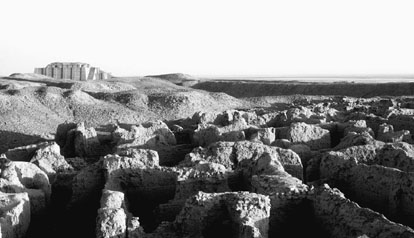

 | Page 1310 |  |
back to the museum. In 1918 and 1919 further explorations and some tests were carried out, but it was not until 1922 that the British Museum (in association with the university of pennsylvania museum) began serious work in the area, under Woolley’s supervision. Between 1922 and 1934 Woolley recovered some of the most magnificent artworks of the ancient world from the cemeteries excavated at the site. Although Ur is justly famous for extraordinary objects made of gold and lapis lazuli, Woolley’s excavations also revealed much about the changes in religious architecture and the evolution of the city and its elites.

Ziggurat and ruined walls of the ancient Sumerian city of Ur in Iraq
(David Lee/Corbis)
References
Woolley, Sir Leonard. 1929. Ur of the Chaldees: A Record of Seven Years of Excavation. London: E. Benn.
(1581–1665)
Born in Dublin, James Ussher was one of the first students of Trinity College, Dublin, which was founded with the help of his family. Ussher studied divinity, Greek, Hebrew, and Latin and became interested in chronology and ecclesiastical antiquarianism. He abandoned the study of law to become a minister in the protestant church of Ireland in 1601. He traveled to England to acquire books for Christ Church College, and while there he met many other Puritan and religious intellectuals and the antiquarians John Camden and Robert Cotton.
Ussher was appointed professor of divinity at Trinity College, Dublin, in 1607, but his title was later changed to professor of theological controversies in recognition of his stance against the Roman Catholic Church and his popularity as a preacher. He was involved in the organization of the Anglican Church in Ireland and came to the notice of King James I, who was impressed by his scholarly vindication of the Protestant and Reformed Church’s position in defense against ongoing Roman Catholic attacks.

James Ussher—an engraving by George Vertue after the portrait by Sir Peter Lely
(Ann Ronan Picture Library)
Ussher was vice-chancellor of the Trinity College, Dublin, and was made a bishop in 1620 and archbishop of Amagh, the primate of Ireland, in 1625. From 1623 to 1626 he lived in London researching his projected work on the antiquities of the British church, which resulted in A Discourse of the Religion Anciently Professed by the Irish and British (1623 and 1631), a defense of the independence of the church in England and Ireland based on the history of the ancient Gallic, Celtic, and British churches before their “contamination” by Rome. In the same vein, he published Britannicarum ecclesiarum antiquitates in 1639, an account of the spread of Christianity in Britain until the seventh century a.d., when St. Augustine arrived in England.
In the last years of his life, Ussher became interested in establishing a universal chronology for the whole of human history, and in 1650, he published Annales veteris et Novi Tesamenti (the English edition, Annals of the Old and New Testament; Or, The Annals of the World Deduced from the Origin of Time, was published in 1658). This work involved research in different oriental languages, comparisons of ancient calendars, and the recalibration of different political and national years with astronomical years, and it was built on the work of other Reformation scholars in France and Holland. The work was a triumph of scholarship and it was the acknowledged universal chronology for as long as the Bible was regarded as absolutely true—until well into the
 |  |